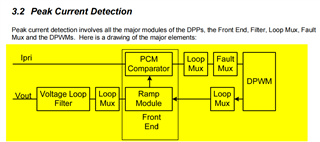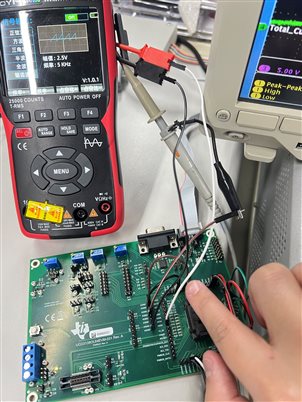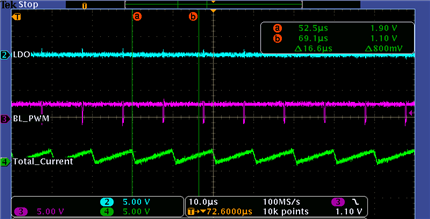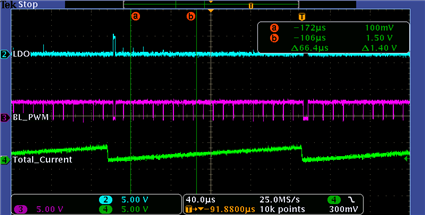Other Parts Discussed in Thread: TIDA-00653,
Tool/software:
Dear TI Experts,
Reference project: TIDA-00653、UCD3138FW-BIDI
We plan to use the TIDA-00653 as a reference circuit and add PCM functionality. However, I found that PCM is controlled by the EADC, and since the TIDA-00653 circuit has four-phase current, it seems that using EADC's PCM for each phase is not feasible.
Currently, we are focusing on CBC. I found that the comparator source for CBC can select a filter as the source. If "ACOMP_x_SEL" selects the filter as the source, does the filter need any specific configuration? Where can we view the corresponding values for the filter source?
Alternatively, do you have other recommendations for PCM control that could be applied to four-phase current?
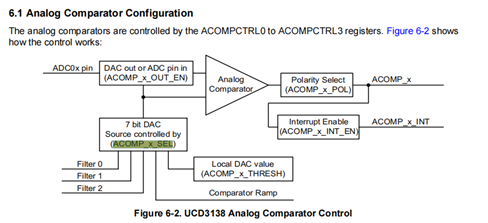
To simply test and verify the configuration EADC0 -> Filter0 -> CBC -> DPWM1, how should I set it up?
Below is my configuration. Is there any issue with these settings? After I completed the setup and enabled the CBC function, DPWMA remains in a fully LOW state. Neither controlling EADC’s EAP0 nor adjusting the DAC_Value produces any change.
void eadc_filter_cbc()
{
/* dpwm 1 */
Dpwm1Regs.DPWMCTRL0.bit.PWM_EN = 0; //disable locally for init
Dpwm1Regs.DPWMCTRL0.bit.CLA_EN = 0; //default is 1 - use cla
Dpwm1Regs.DPWMCTRL0.bit.PWM_MODE = 0; //normal mode
Dpwm1Regs.DPWMPRD.all = DPWM_PERIOD; //use .all for all values, make sure scaling matches.
Dpwm1Regs.DPWMEV1.all = (DEAD_TIME_1) + 10; //Put event 1 at start of period
Dpwm1Regs.DPWMEV2.all = ((DPWM_PERIOD) >> 1) - (DEAD_TIME_2) / 2; //1/4 of period - divide is OK because it's all constants.
Dpwm1Regs.DPWMEV3.all = ((DPWM_PERIOD) >> 1) + (DEAD_TIME_2) / 2; //1/2 of period
Dpwm1Regs.DPWMEV4.all = 10;
Dpwm1Regs.DPWMSAMPTRIG1.all = 2000;
Dpwm1Regs.DPWMMINDUTYHI.all = 2250;
Dpwm1Regs.DPWMMINDUTYLO.all = 2250;
Dpwm1Regs.DPWMCTRL0.bit.MIN_DUTY_MODE = 2;
Dpwm1Regs.DPWMCTRL0.bit.PWM_EN = 1; //enable locally
/* filter 0 */
Filter0Regs.FILTERKPCOEF0.bit.KP_COEF_0 = 1;
Filter0Regs.FILTERKICOEF0.bit.KI_COEF_0 = 0;
Filter0Regs.FILTERKDCOEF0.bit.KD_COEF_0 = 0;
Filter0Regs.FILTERKDALPHA.bit.KD_ALPHA_0 = 0;
Filter0Regs.FILTERKICLPHI.bit.KI_CLAMP_HIGH = 0x7FFFFF;
Filter0Regs.FILTERKICLPLO.bit.KI_CLAMP_LOW = 0;
Filter0Regs.FILTEROCLPHI.bit.OUTPUT_CLAMP_HIGH = 0x7FFFFF;
Filter0Regs.FILTEROCLPLO.bit.OUTPUT_CLAMP_LOW = 0;
Filter0Regs.FILTERCTRL.bit.FILTER_EN = 1;
// enable OK here, because nothing will happen until DPWM and front end are globally enabled
// Better option for handling shoot through - uses full dynamic range of filter
Filter0Regs.FILTERCTRL.bit.OUTPUT_MULT_SEL = 1; // select half period kcomp for output multiplier
/* loop mux */
// LoopMuxRegs.DPWMMUX.bit.DPWM0_FILTER_SEL = 0; // use filter 0 for DPWM 1
LoopMuxRegs.SAMPTRIGCTRL.bit.FE0_TRIG_DPWM1_EN = 1; // use DPWM1 for filter0 sample trigger
LoopMuxRegs.FILTERMUX.bit.FILTER0_FE_SEL = 0; // connect filter 0 to front end 0.
LoopMuxRegs.FILTERMUX.bit.FILTER0_PER_SEL = 1; // Selects source of switching cycle period for Filter 0 Module
/* eadc */
FeCtrl0Regs.EADCDAC.bit.DAC_VALUE = 8192;
FeCtrl0Regs.EADCCTRL.bit.AFE_GAIN = 2;
/* global */
union GLBEN_REG glben_store; // collect global enable bits for simultaneous use
glben_store.all = 0;
glben_store.bit.DPWM1_EN = 1;
glben_store.bit.FE_CTRL0_EN = 1;
LoopMuxRegs.GLBEN = glben_store;
/* cbc - dpwm1 */
//Phase 1 CBC
FaultMuxRegs.ACOMPCTRL0.bit.ACOMP_B_SEL = 2; // 2 = Analog Comparator B Threshold set by Filter 0 Output
FaultMuxRegs.ACOMPCTRL0.bit.ACOMP_B_POL = 1; // 1 = Comparator result enabled when input exceeds threshold (Default)
FaultMuxRegs.ACOMPCTRL0.bit.ACOMP_EN = 1; //1 = Analog Comparators Enabled
FaultMuxRegs.DPWM1CLIM.bit.ACOMP_B_EN = 1; //AD03 //1 = Analog Comparator result enabled for current limit
Dpwm1Regs.DPWMCTRL0.bit.CBC_ADV_CNT_EN = 1; //1 = CBC enabled (pwm mode: normal mode)
Dpwm1Regs.DPWMCTRL0.bit.CBC_PWM_AB_EN = 1; //1 = PWM-A and PWM-B affected by Fault CBC
}


